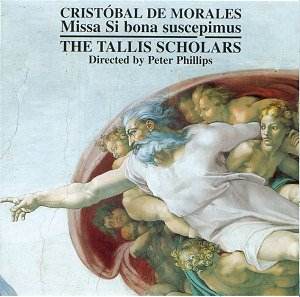Cristóbal de MORALES
Missa Si bona suscepimus
 The Tallis Scholars directed
by Peter Phillips
The Tallis Scholars directed
by Peter Phillips
 Gimell CDGIM 033
[56:01]
Gimell CDGIM 033
[56:01]
Crotchet

Sometimes it is easy to become blasé, to think that here is just yet
another fine early music release: ho, hum. Yet every CD released represents
an enormous effort on the part of many dedicated and talented individuals,
and here, as seems so often in the field of early music, we are treated to
another superlative issue. This is something special.
Preceding the title work is the Si bona suscepimus by Philippe Verdelot,
a short piece [6:58 in this performance] published in 1526 and upon which
Morales based his much more extensive mass. Verdelot used quotations from
Job, particularly the repeated phrase, 'The Lord has given, the Lord
has taken away.' Morales retained the structure - Verdelot's music is melodic
yet austere - and erected a much more elaborate development, resulting in
one of the masterpieces of polyphony. One interesting point is that Morales
was appointed to the Papal Choir on the same day that Michelangelo was
commissioned by Pope Paul III to paint the Last Judgement, and so,
as Peter Phillips himself notes in the accompanying booklet, singing in the
Sistine Chapel, the composer would have seen this most celebrated example
of Catholic art come into being day by day. During this same period Morales
composed the Missa Si bona suscepimus, publishing it in 1544, three
years after the completion of the Last Judgement.
The mass is in five sections, forming an arch structure around the central
Credo: Kyrie, Gloria, Credo, Sanctus & Benedictus, Angus Dei I, II &
III. At almost 13 minutes the Credo really is an epic centrepiece, the sustained
combination of invention and repetition continuously holding the attention.
There are 18 singers, though not all appear on each track, and the combined
sound is cleanly defined in the space of the Church of Saint Peter and Saint
Paul, Salle in Norfolk, with the sense of place being so uncannily accurate
as to seem really quite disconcerting emerging from the speakers in a modern
house. Do listen with your eyes closed to preserve the illusion. Every sibilance
is caught, there is nothing ethereal about this very real music-making, and
indeed the sound can be just a little hard and dry on the more declamatory
phrases. None of this seriously detracts because this is exceptional music,
performed with great commitment by very fine singers. In moments where the
soprano Ghislaine Morgan soars over, through and between the intertwined
alto and tenor voices I for one was transported.
The programme ends with a motet long attributed to Morales, now thought to
be the work of the Franco-Flemish composer Thomas Crecquillon. Whoever wrote
Andreas Christi Famulus, this little known piece makes an imaginative
and satisfying conclusion to a remarkable concert. Gimell's presentation
is first class too.
Gary S. Dalkin


